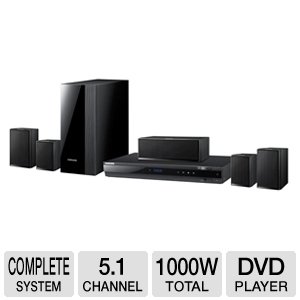!±8± Samsung Electronics HT-D550 Home Theater System
 | Price : $179.96
| Price : $179.96Post Date : Feb 29, 2012 06:59:49 | Usually ships in 1-2 business days
Enjoy immersive surround sound and 1080p high-definition visuals with the Samsung HT-D550 Home Theater System, which includes a DVD player, a 5.1-channel surround sound speaker set (subwoofer, center channel, and four satellite speakers), and 1000 watts of booming power. Additionally, you'll be able to connect your iPod or iPhone and listen to music or watch videos thanks to the included dock.

Key Features
Syncs with an iPod or iPhone
Set your iPod or iPhone in your home theater's docking cradle enjoy your favorite songs, videos and photos on a much bigger screen. Switch songs, control the volume or go from podcasts to photos, all with your home theater remote. Your iPhone or iPod even charges while it plays.
Sync movies from PC with DivX HD
Watch downloaded movies on your TV, in all their big-screen glory. With Divx playback, your Blu-ray player can read DVDs and CDs containing Divx movie files you've downloaded to a PC-without needing an adapter.
High-definition sound with Dolby True HD
Dolby TrueHD delivers high-definition sound that's just as stunning as your TV's HD picture. With advanced lossless, multi-channel audio codec technology, you'll be immersed in sound that's identical to the studio master recording.
High-definition sound with HD Master Audio
DTS-HD Master Audio delivers sound so pure and powerful, you'll feel like you're at the original master recording. Because what you hear is identical to what the sound engineers originally laid down.

Decreased power usage with Eco Power System
Reduce your power consumption while optimizing performance. It's a home theater system that saves energy and saves you on your electric bills.
Two-times the resolution with 1080p
With nearly twice the resolution of conventional HDTVs, the 1080p Full HD picture offers spectacular detail--rich, eye-popping colors, the highest contrasts and super-sharp, ultra-realistic images. So everything on your screen looks better than you ever imagined.
Cinematic sound with HD Audio
Feel like you're part of the action onscreen. Immerse yourself in pure surround sound with dramatic depth of detail. And don't compromise on Dolby Digital Plus sound or the high-def, uncompressed sound of DTS-HD Master Audio and Dolby TrueHD, which can only be played on the highest quality AV systems.
Stream PC content with Wireless LAN Adaptor
Plug an optional Wireless LAN Adaptor into the back of DVD player and play content from your PC right through it. Works with DivX, MP3 and JPEG-HD media files. PC-streaming turns your living room into the ultimate multimedia experience.Specifications
- Total power output: 1000 watts
- Outputs: 1 HDMI, 1 component (Y/Pb/Pr), 1 composite AV
- Inputs: 2 component, 1 composite, 1 optical audio, iPod docking connection
- Surround sound formats: Dolby Digital, Dolby Pro Logic II, DTS
- Main unit dimensions: 16.93 x 9.8 x 2.1 inches
- Subwoofer dimensions: 6.6 x 11.6 x 13.7 inches
- Center channel dimensions: 14.2 x 2.7 x 2.9 inches
- Satellite dimensions: 3.5 x 2.6 x 5.5 inches
- Warranty: 1 year
What's in the Box
DVD player/amplifier; 5.1-channel surround sound speakers (subwoofer, center channel, four satellites); remote control (with batteries); iPod dock; AV cable; FM antenna; operating instructions









